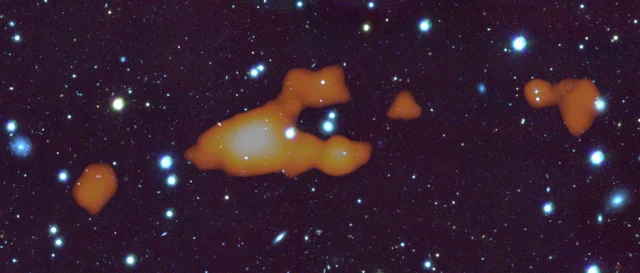
A collaboration between Rhodes University astronomers, University of Cape Town (UCT), and Swinburne University of Technology (SUT) based in Melbourne, Australia, has discovered a mysterious chain of hydrogen gas clouds with the size of a massive galaxy through the South African MeerKAT radio telescope. The international team is led by an Astronomer from the Max-Planck Institute for Radio Astronomy and Rhodes University visiting Professor Gyula Józsa, SUT’s Professor Michelle Cluver, and Professor Thomas Jarrett from UCT.
Professor Józsa explained: “Only a handful of cloud complexes with similarities to this one are known, and our discovery seems to differ in quite some key aspects. The simplest explanation would be a tidal interaction between galaxies, the gas being ripped out of the host galaxies in a close encounter. But how the six of seven supermassive concentrations without any stars can be formed in such an event still needs to be explained.”
The accumulation of so much elemental hydrogen without associated stellar components is the largest yet discovered. Appearing at the edge of a relatively massive group of galaxies, there is the possibility that the cloud chain is gas stripped from group-member galaxies, but it may also be primordial and gravitationally drawn into the group through a cosmic filament pathway. Whatever the case, MeerKAT is proving to be a ground-breaking telescope, and many such discoveries should soon follow this “dark” cloud discovery in the exciting days ahead.
The discovery of the mystery clouds will be published in the renowned Astrophysical Journal under the title: “The detection of a massive chain of dark HI clouds in the GAMA G23 Field“.
“Cosmic filaments are the highways along which mass concentrations come together under the action of gravity. We expect gas-rich galaxies to be associated with these structures, using their neutral hydrogen as a fuel for star formation and growth. We, therefore, designed our blind shallow survey to search for this type of gas along such a filament. And indeed, we found gas in many galaxies, but we did not expect anything like these clouds. They form a huge complex of tenuous atomic hydrogen gas that stretches over a distance of 1.3 million light-years. Seven spots of concentrated gas can be discerned from the complex,” said Professor Cluver.
The puzzling thing: despite its extraordinarily-large gas mass (equivalent to 10 billion of our Sun’s mass), there are close to no stars in the vicinity of the complex. Normally, any cool gas like atomic hydrogen is associated with their ‘home’ galaxy, where the gas reservoir continues to feed and grow the galaxy over eons of time. Such a large cloud cannot survive on its own: floating freely, the local environment is far too harsh as it gets heated up and ionised by the radiation from surrounding galaxies. Only the gravitational pull of a galaxy can, in principle, compact a cloud to a degree where it gets dense enough to create a natural shield against the cosmic background radiation.
Professor Jarrett said: “We were very surprised that we did not find any indication of a significant amount of stars, despite our thorough search using very deep ultraviolet, optical and infrared imaging. There have to be stars; it’s inconceivable for a cloud the size of a galaxy to simply be floating in space!”
There is one possible exception to this, where a small dwarf galaxy is seen close to one corner quadrant of the cloud complex, leaving at least six dark clouds. Yet, it is far too small to possibly be the origin of all this gas.
Click here for a 3D rendering of the dark cloud chain
No obvious connection to any donor galaxy is evident from the data. The existence of these “dark clouds” is hence a mystery yet to be solved. Maybe the complex enters the group for the first time, consisting of primordial gas gravitationally pulled into the galaxy group along a cosmic filament. Now that the clouds have been discovered, the researchers hope it will be possible to learn about their origin using dedicated, much-more-profound observations with several telescopes in the southern hemisphere. Solving this puzzle could have exciting implications for understanding atomic hydrogen's role in how galaxies evolve in large-scale structures.
The other Rhodes University astronomers involved are: Professor Oleg Smirnov, Centre for Radio Astronomy Techniques and Technologies, Department of Physics & Electronics and SKA Research Chair; Dr Sarah V. White, Department of Physics and Electronics, Rhodes University – SARAO Postdoctoral Fellow
